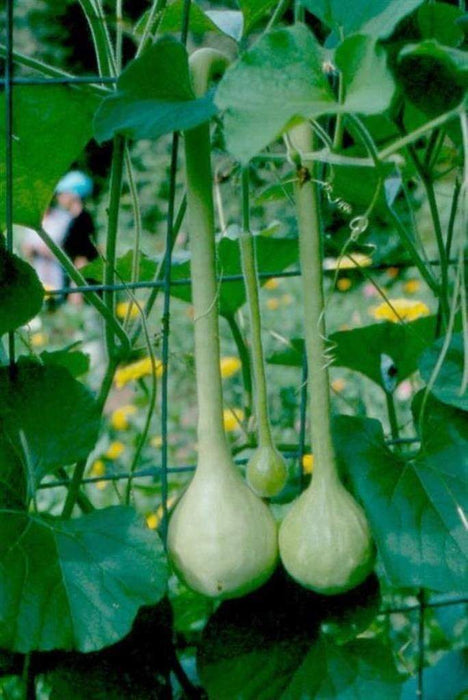
Dipper Gourd Seeds,12" long necks, Asian Vegetable
Most orders are processed by the next day
Select your desired size and/or color from the available options.
Dipper Gourd Seeds,12" long necks and bulbs with a diameter of 5-7" use as a container,bottles, or musical instruments.
BOUT GOURD
Gourds have as many uses as they do shapes, colors and textures. Bitter Melons are particularly good stuffed with meat, seafood or beans, as are hairy melons, especially when stuffed with pork and baked. Bottle and Calabash Gourds are excellent in meat soups or stir-fries. Young Luffas can be prepared just like zucchini. And while used in a variety of Asian dishes, the Winter Melon is the key ingredient for the famous winter melon soup, popular at Chinese banquets. The soup is cooked in the melon itself, and chunks of melon flesh are scooped out and served with the soup. Gourds used for eating and cooking should be harvested young, as they tend to grow bitter the longer they are left on the vine.
DIPPER GOURD SEEDS
PRODUCT DESCRIPTION
Open Pollinated
(Lagenaria siceraria)
Annual. 60 days. 6-12" height. 5-6' spacing. Produces light/dark green gourds with 12" long necks and bulbs with a diameter of 5-7".
About Dipper Gourd: The origin of gourds has been a subject of debate for decades. Archaelogical findings seem to show that Asia first domesticated the gourd for use as a container, though Africa and several island
nations such as Polynesia and New Zealand also have an early history of using gourds as fishing floats, bottles, or musical instruments. Recent research shows that North America's gourds are nearly as old as those of Asia, which seems to suggest that early peoples who settled in the New World brought gourds with them.
Dipper Gourd Germination: In shorter growing seasons, start gourd seeds indoors in peat pots 3-4 weeks before the last frost. To speed germination, soak the seeds overnight. Plant the seedlings outdoors in rich soil and
full sun after the last spring frost. For direct sowing, wait until the soil warms to 70 degrees F, then plant 5 seeds per hill, 1" deep, with 5' spacing; later, thin to the strongest plant.
Growing Dipper Gourd Seeds: Keep the soil evenly moist. When the vines begin to develop, either provide a trellis or lay down mulch to keep the gourds from contact with the soil; too much soil contact can weaken the
shell, distort the shape, and cause rotting.
Harvesting Dipper Gourd: Late in the summer, the stem and leaves of the gourd will wither and turn brown; cut off the gourd, leaving about 2" of stem. Wash it with a solution of white vinegar and water to deter mold.
Place them in a warm, dry location on a screen so that every side of the gourd has good air circulation. If the gourd begins to rot and shrivel up, throw it away; surface mold is normal. Dipper gourds may take several weeks
or a month to dry, depending on the size. When completely dry, they will be extremely lightweight and the seeds will rattle inside.
Saving Dipper Gourd Seeds: After the gourds have completely dried so that the seeds inside rattle, remove the seed by cutting open the gourd or drilling a hole in the shell. Spread out the seeds to dry; when a seed will
snap in two, it has dried sufficiently. If the seed only bends but will not break, further drying time is needed. Store the dry seeds in a cool, dry place for up to six years
LET OUR CUSTOMER SPEAK FOR US

![[Seeds] - Caribbeangardenseed](http://caribbeangardenseed.com/cdn/shop/files/gift-card-gift-card-1_1024x1024_dfa857db-9150-4315-a362-7f0bb3fb9c47_60x28.png?v=1703978838)



